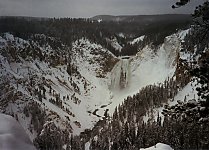 The
Lower Falls of the Yellowstone, in winter. Notice the ice cone that
partly covers the falls. Notice that there is less water going over
the falls than in the summer.
The
Lower Falls of the Yellowstone, in winter. Notice the ice cone that
partly covers the falls. Notice that there is less water going over
the falls than in the summer. The
Grand Canyon of the Yellowstone. The canyon area was, and still is
to some extent, a thermal area. The action of the hot water caused
the rocks to "rot", which made them soft and crumbly, and allowed the Yellowstone
River to cut the deep canyon. The thermal activity stained the rocks
brilliant orange and red colors too. These colors are more evident
when it is a sunny day, and in summer when they are not covered in snow.
Check out this summer picture taken
from the bottom of the canyon.
The
Grand Canyon of the Yellowstone. The canyon area was, and still is
to some extent, a thermal area. The action of the hot water caused
the rocks to "rot", which made them soft and crumbly, and allowed the Yellowstone
River to cut the deep canyon. The thermal activity stained the rocks
brilliant orange and red colors too. These colors are more evident
when it is a sunny day, and in summer when they are not covered in snow.
Check out this summer picture taken
from the bottom of the canyon.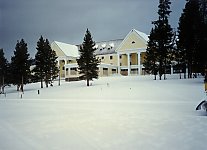 The
Lake Hotel. It is very old, the oldest hotel in the park, big, supposedly
the second largest wood frame building in the U.S., and elegant by Yellowstone
standards. Here it is put away for the winter.
The
Lake Hotel. It is very old, the oldest hotel in the park, big, supposedly
the second largest wood frame building in the U.S., and elegant by Yellowstone
standards. Here it is put away for the winter.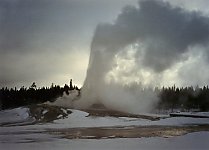 Lion
Geyser, Upper Geyser Basin. Lion is a fairly active, fairly big (30
- 70 feet) cyclic geyser on the Geyser
Hill of the Upper Basin. It got it's name because it sort of
"roars" with quick bursts of steam before an eruption. To me the
roars sound more like a quick warning growl. If you were to spend an hour
or two on Geyser Hill you would have a good chance of seeing Lion
erupt if you are there during of one of it's cyclic series of eruptions.
Lion
Geyser, Upper Geyser Basin. Lion is a fairly active, fairly big (30
- 70 feet) cyclic geyser on the Geyser
Hill of the Upper Basin. It got it's name because it sort of
"roars" with quick bursts of steam before an eruption. To me the
roars sound more like a quick warning growl. If you were to spend an hour
or two on Geyser Hill you would have a good chance of seeing Lion
erupt if you are there during of one of it's cyclic series of eruptions. A
coyote scavenging cooked buffalo meat at Scalloped Spring, Upper Geyser
Basin. It is not only the two legged variety of animals that sometimes
fall into hot springs. The four legged kinds will also step where
they shouldn't and get cooked because of it. If you look around,
you can see bones in several of the quiet, clear hot springs in Yellowstone.
A
coyote scavenging cooked buffalo meat at Scalloped Spring, Upper Geyser
Basin. It is not only the two legged variety of animals that sometimes
fall into hot springs. The four legged kinds will also step where
they shouldn't and get cooked because of it. If you look around,
you can see bones in several of the quiet, clear hot springs in Yellowstone.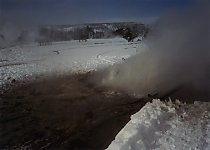 Scalloped
Spring in eruption. This is not something you see every day.
Scalloped Spring used to be a non erupting hot spring with ornate scallops
around the edge of an overflowing pool, much like nearby South Scalloped
Spring. It was illegally induced to erupt (before my time, and no,
I won't say how to make a spring erupt) and this caused the water level
to fall several feet below the surface where it boils, and rises and falls,
but does not normally erupt. Something about having a bison fall
into the spring made it erupt for a day or two this particular winter.
It was erupting about every minute or two when I was there, throwing smelly
brown buffalo soup anywhere from a foot to say maybe eight or ten feet
high and angled toward the boardwalk. You can see where the snow
on the boardwalk has been melted by the splashing water.
Scalloped
Spring in eruption. This is not something you see every day.
Scalloped Spring used to be a non erupting hot spring with ornate scallops
around the edge of an overflowing pool, much like nearby South Scalloped
Spring. It was illegally induced to erupt (before my time, and no,
I won't say how to make a spring erupt) and this caused the water level
to fall several feet below the surface where it boils, and rises and falls,
but does not normally erupt. Something about having a bison fall
into the spring made it erupt for a day or two this particular winter.
It was erupting about every minute or two when I was there, throwing smelly
brown buffalo soup anywhere from a foot to say maybe eight or ten feet
high and angled toward the boardwalk. You can see where the snow
on the boardwalk has been melted by the splashing water.
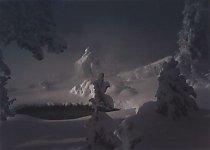 Eerie
looking trees by a hot spring, Upper Geyser Basin. Trees will sometimes
get covered with ice from condensed steam or geyser spray in the winter.
Then they get to be called ghost trees.
Eerie
looking trees by a hot spring, Upper Geyser Basin. Trees will sometimes
get covered with ice from condensed steam or geyser spray in the winter.
Then they get to be called ghost trees.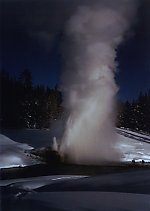 Riverside
Geyser, Upper Geyser Basin. Riverside is a large, very predictable
geyser. Predictions are usually posted in the Old Faithful Visitors
Center. Riverside is actually more regular than Old Faithful.
The interval between eruptions is longer than for Old Faithful (5.5 to
8.5 hours), but the eruption lasts much longer, about 20 minutes.
This gives plenty of time for getting lots of shots from different angles,
and for just sitting back and watching the show. It is also very
pretty the way the water column arches out over the Firehole River.
Riverside
Geyser, Upper Geyser Basin. Riverside is a large, very predictable
geyser. Predictions are usually posted in the Old Faithful Visitors
Center. Riverside is actually more regular than Old Faithful.
The interval between eruptions is longer than for Old Faithful (5.5 to
8.5 hours), but the eruption lasts much longer, about 20 minutes.
This gives plenty of time for getting lots of shots from different angles,
and for just sitting back and watching the show. It is also very
pretty the way the water column arches out over the Firehole River.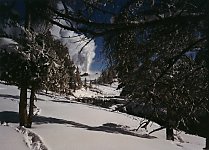 Lion
Geyser from down the hill.
Lion
Geyser from down the hill.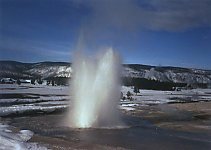 Plume Geyser, Upper Geyser Basin. Plume is usually fairly active, with
eruptions about every half hour to hour in recent years I have seen it,
but it's activity is prone to change. Actually, all features can
change, it's just Plume does so maybe more than most. It was created
by a steam explosion in 1922. In 1972 another steam explosion opened
another vent, and it now erupts only 20 to 25 feet high, instead of 40
ft. The interval between eruptions can even change with the time
of day - sometimes runoff from other springs flows into Plume. During
the night and the morning this runoff is colder and has more of a quenching
action than in the afternoon when the runoff is warmer, and causes the
intervals to lengthen. If Plume is very active when you visit (you
can ask the rangers at the Visitors Center, that is what they are paid
for) it is worth the wait. You are close to the geyser, and can watch
the water rapidly fill the vent. Then there is a very quick burst,
and the vent drains. The water usually wells back up for a second,
a third, and sometimes a fourth burst. At least that is what Plume
was doing when I was there last.
Plume Geyser, Upper Geyser Basin. Plume is usually fairly active, with
eruptions about every half hour to hour in recent years I have seen it,
but it's activity is prone to change. Actually, all features can
change, it's just Plume does so maybe more than most. It was created
by a steam explosion in 1922. In 1972 another steam explosion opened
another vent, and it now erupts only 20 to 25 feet high, instead of 40
ft. The interval between eruptions can even change with the time
of day - sometimes runoff from other springs flows into Plume. During
the night and the morning this runoff is colder and has more of a quenching
action than in the afternoon when the runoff is warmer, and causes the
intervals to lengthen. If Plume is very active when you visit (you
can ask the rangers at the Visitors Center, that is what they are paid
for) it is worth the wait. You are close to the geyser, and can watch
the water rapidly fill the vent. Then there is a very quick burst,
and the vent drains. The water usually wells back up for a second,
a third, and sometimes a fourth burst. At least that is what Plume
was doing when I was there last.back to the Yellowstone Pictures Page